Ocean Worlds and Space
There are ample “ocean worlds” spread across our universe, but we are limited in our ability to understand them by our own technology. That being said, there are several Ocean Worlds close to home – in our own solar system, or in “nearby” solar systems that are observable to us.
Where do we find Ocean Worlds? Moons in our solar system….
Europa is one of Jupiter's moons, where scientists strongly suspect a salty, subsurface ocean lies beneath its icy exterior, thought to be made of a similar elemental composition to that of Earth. It is, however, thought to be significantly deeper, possibly 100 km compared to a ~3km ocean average on Earth. Jupiter's gravity may forces tides like those we have on Earth, which could provide tidal heating via friction between the ocean and ice layer to maintain the ocean's liquid state, and might even partially melt pockets (lakes) throughout the shell. Hubble Space Telescope has spotted possible water plumes erupting from the moon's surface.
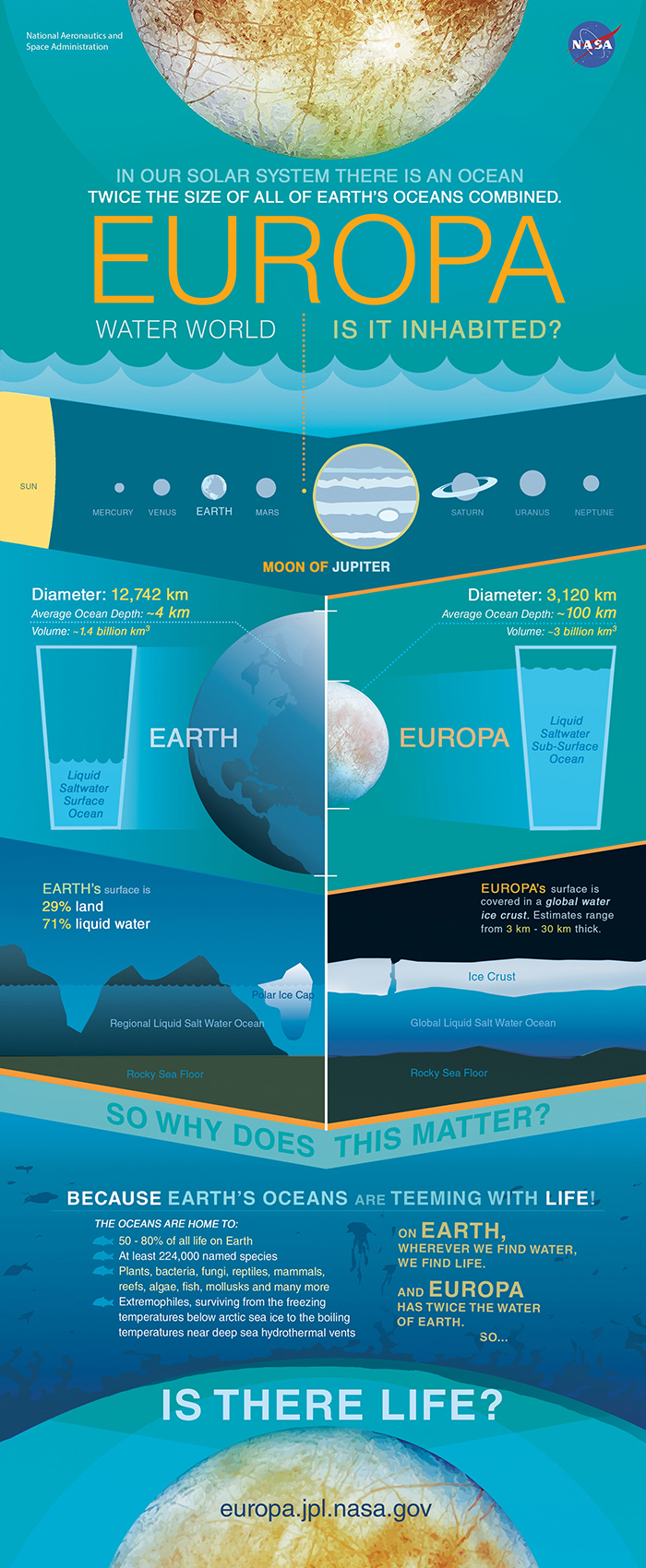
This figure can be found on NASA's Europa Clipper Webpage, and was developed by NASA/JPL-Caltech in 2019. It demonstrates that the compositions of Europa and Earth's oceans are thought to be similar (in terms of elemental chemistry). This means that Europa is a very interesting potential habitat for life. Learn More!
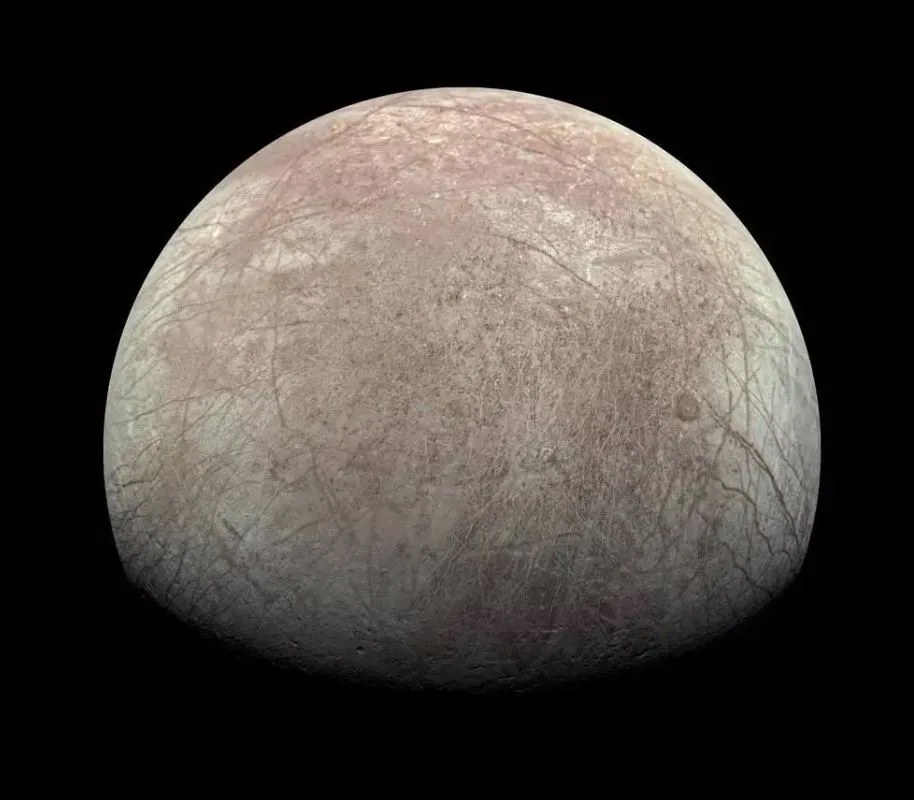
This view of Jupiter's icy moon Europa was captured by the
JunoCam imager aboard NASA's Juno spacecraft during the
mission's close flyby on Sept. 29, 2022. The agency's
upcoming Europa Clipper spacecraft will explore the moon.
Image credit:
NASA/JPL-Caltech/SwRI/MSSS Image processing: Kevin M. Gill
CC BY 3.0
Astrobiologists think that Europa could be a good candidate for life, like Earth, as it has abundant water and important elements present on its surface (C, H, N, O, P, and sulfur). Europa does not, however, receive much sunlight below the ice (where life could exist), which means it is likely if there were life, it would be chemosynthetic. This could be similar to life in the deep ocean, for example.
Ganymede is Jupiter’s largest moon and the largest moon in our solar system – it is larger than Mercury and Pluto – it is even large enough to have its own magnetic field! Studies such as this one have found evidence of a global, subsurface salty ocean; there may even be several layers. Hubble Space Telescope has constrained this ocean to perhaps be larger than all of the water on Earth's surface.
Ganymede is typically much colder than Earth, but there is evidence of a thin oxygen atmosphere on Ganymede, which makes it an interesting ocean world to study as compared to Earth. Ganymede has its own magnetosphere, as well, which is unique to this particular moon: a magnetosphere is present on many planets, but on no other moons that we've seen so far.
Another moon of Jupiter's, Callisto, is iconic for its cratered surface. Callisto is the furthest Galilean satellite from Jupiter, with ~26 radii of Jupiter between it and its planet. Below this surface is an ice layer of ~200 kilometers (124 miles) thick. Beneath that ice, it is hypothesized there might be an ocean that is 10 kilometers (6 miles) deep. For reference, the Mariana Trench on Earth is almost 11 kilometers deep.

Bright scars on a darker surface testify to a long history
of impacts on Jupiter's moon Callisto in this image of
Callisto from NASA's Galileo spacecraft.
Image credit:
NASA/JPL/DLR
Callisto's surface is about 4 billion years old, so it hosts a lot of information about the development of our solar system. Its atmosphere is mostly carbon dioxide, but also has oxygen and hydrogen (at least in the exosphere) - some of the important makings of life. It appears Callisto has a salty ocean, as well, which might be able to host life.
Triton is a moon of Neptune, with active geysers that spew nitrogen gas. There are volcanic features and fractures on the cold, icy surface of Triton, meaning there may have possibly been past tides. It is not confirmed that there is a subsurface liquid ocean on Triton, but it is certainly possible.

A view of Triton from NASA's Voyager 2 spacecraft during its
flyby of the Neptune system in 1989.
Image credit:
NASA/JPL/USGS
Like Earth, Triton's atmosphere is mostly nitrogen (with small amounts of methane). This methane is likely from volcanic activity, which makes it one of the only three bodies in the solar system that is volcanically active at this time – as a result, it has active geysers.
Titan is a moon of Saturn that is believed to have a saltwater subsurface ocean, found as deep as about 30 miles below its icy exterior. It's even thought that the subsurface ocean might be as salty as the Dead Sea on Earth. It's possible that the liquid water ocean on Titan is thin, and sandwiched between layers of ice, or thick, and extends to the rock at the interior of the moon. There are liquid hydrocarbon seas, lakes, and rivers on Titan's surface, made up predominantly of methane and ethane. You can watch an interview of an expert on Titan by the American Astronomical Society here.

Ligeia Mare, shown here in a false-color image from NASA's
Cassini mission, is the second largest known body of liquid
on Saturn's moon Titan. It is filled with liquid
hydrocarbons, such as ethane and methane, and is one of the
many seas and lakes that bejewel Titan's north polar region.
Image credit:
NASA/JPL-Caltech/ASI/Cornell
Titan is actually one of the most hospitable worlds in the solar system, with a nitrogen atmosphere (not unlike our own) that is so dense, humans could walk around without a pressure suit. Titan's surface is very cold, and lacking in oxygen, but has gravity about equivalent to Earth's moon. Titan has plenty of hydrogen and carbon present, mostly in the form of liquid hydrocarbon rivers, lakes, rain, clouds, and seas (ethane and methane). There is water present, mostly in the form of ice at the surface, but below is a liquid water ocean that could house life.
Enceladus is one of Saturn's moons that has a global ocean of liquid water underneath its icy (solid water) exterior. The underground ocean on Enceladus vents into space, spraying a water vapor plume into space from so-called “tiger stripes” near the moon's south pole. This plume has organic and nitrogen-bearing molecules (acetylene, ammonia, carbon dioxide, methane) as well as silica. All of these molecules are ones foundational to Earth's ecosystems and life today.

NASA's Cassini spacecraft found that Enceladus, an icy and
geologically active moon of Saturn, also contains a global
ocean with evidence of hydrothermal activity.
Image credit:
NASA/JPL/Space Science Institute
Mimas is one of the innermost, smallest mid-sized moons of Saturn. Cassini has identified a signature of a potential ocean under the icy exterior of Mimas' shell.

Mimas has large geysers of water, implying that there is
heat internally that allows its icy surface to melt at
higher pressure.
The majority of Mimas seems to be water ice
– so there is water, but is there anything else necessary
for life like that we see on Earth?
Image credit:
NASA/JPL-Caltech/Space Science Institute
Where do we find Ocean Worlds? Dwarf Planets...
NASA's Dawn Mission allowed scientists to see that Ceres, a dwarf planet in the asteroid belt within our solar system, has pockets of subsurface, liquid ocean. Ceres itself is a giant ice ball, which led to speculation that at one point, this frozen water might have been liquid. Scientists have seen variations in Ceres' gravitational field, indicating an underground reservoir of up to hundreds of kilometers wide and up to 40 kilometers (25 miles) deep. It is thought that this ocean is approximately the size of Utah's Great Salt Lake.

NASA's Dawn probe orbited Ceres starting 6 March 2015. This
image shows Ceres' north end, taken in April 2015.
Image credit:
NASA/JPL-Caltech/UCLA/MPS/DLR/IDA
NASA's Dawn probe entered Ceres's orbit on 6 March 2015. This image, taken in mid-April of that year, shows Ceres's northern end. Mars(?)
Dwarf planet Pluto has towering mountains of water ice (H2O) and glaciers made of nitrogen and methane-based ice. There are mysterious fault lines on its surface of up to 100 miles long, and additional basin evidence, indicating there might be an ocean hidden beneath its surface.
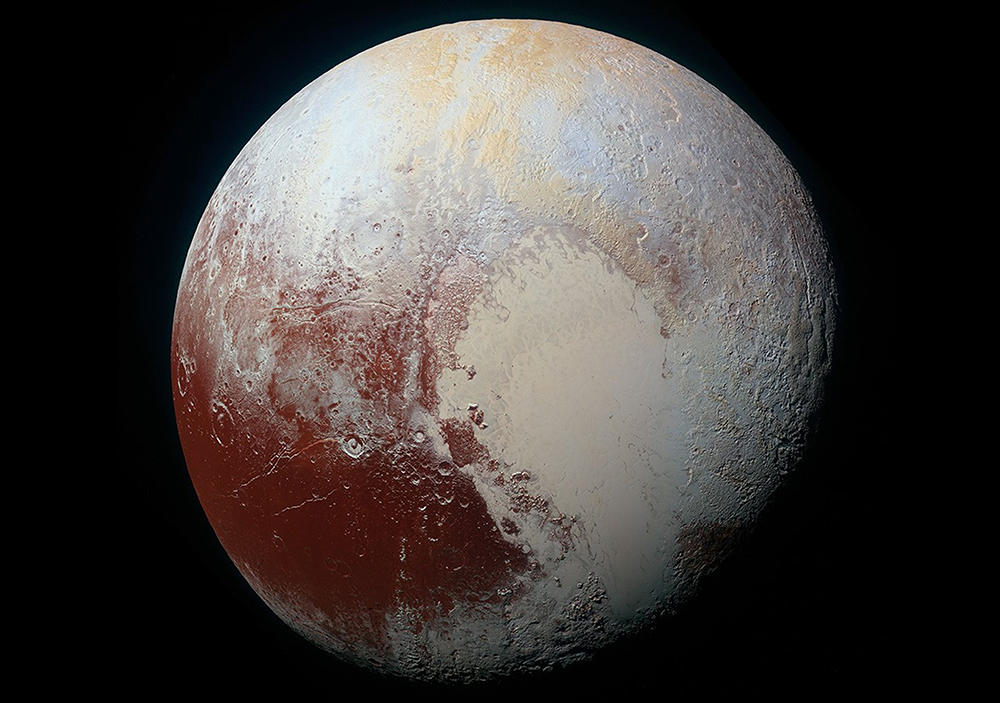
NASA's New Horizons spacecraft captured this
high-resolution, enhanced color view of Pluto in 2015.
Image credit:
NASA/JHUAPL/SwRI
Pluto is extremely cold due to its distance from the sun, and thus likely does not host life. Water is completely solid on Pluto, but it is present, and it is hypothesized that there could be a liquid ocean in its interior. Like Earth, its atmosphere is mainly molecular nitrogen, but there are small traces of methane and carbon monoxide.
Where do we find Ocean Worlds? Planets...
A subglacial lake was discovered almost a mile below Mars' south polar surface by the Mars Advanced Radar for Subsurface and Ionosphere Sounding (MARSIS). The hypothesis that there might be basal melting under Mars' polar ice caps first appeared in the 1980s. Researchers believe that perchlorate (or alternatively, saline ice or hydrous minerals) dissolved in the water lowers the freezing temperature, allowing liquid water to pool. This is particularly interesting to microbiologists on Earth, who have found microbial ecosystems in deep subglacial lakes on Earth (e.g., Lake Whillans in Antarctica, under 800m of ice). As we find life on Earth in analog ecosystems, this raises the question of life on Mars.
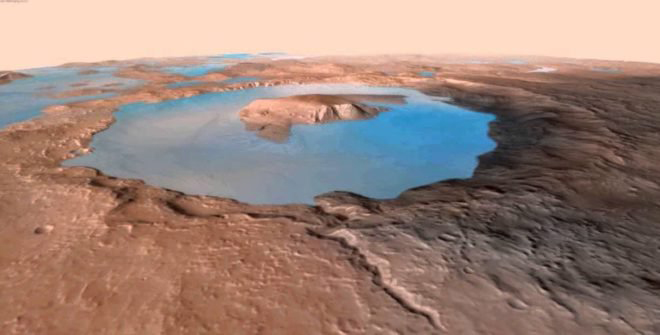
Rendering of Gale Lake some 3.5 billion years ago, when Mars
was warmer and much wetter. The Curiosity mission is finding
that rocke in Gale Crater changed by water everywhere.
Image credit:
Evan Williams, with data from the Mars Reconnaissance
Orbiter HIRISE project)
Where do we find Ocean Worlds? Outside of our solar system….
HAT-P-11b is a planet on which water vapor has been discovered. HAT-P-11b is ~120 light years away, in the constellation of Cygnus. It is in a 5-day orbit of its star, and is likely too warm for liquid oceans (possibly due to its close proximity to its star). HAT-P-11b is approximately as big as Neptune and has clear, cloudless skies.

A Neptune-sized planet with a clear atmosphere, HAT-P-11b,
is shown crossing in front of its star in this illustration.
Image credit:
NASA, ESA, and R. Hurt (JPL-Caltech)
Beta Pictoris is ~63.4 light-years from our solar system, is 1.75 times as massive as, and 8.7 times as luminous as the sun. While it is not clear in what form, water molecules have been found in planets orbiting this star.
All of these Keppler-XXs are in confirmed orbits in a star's “habitable zone.” Kepler-22b is ~2.4 times the size of Earth, and scientists look forward to investigating whether -22b is gaseous, liquid, rocky, or a combination of these. Kepler-452b is roughly the size of Earth, circling a star that is about 120% the brightness of our own sun. Its orbit is 385 days, a little bit longer than Earth's year, and is ~6 billion years old. Kepler-62, a star ⅔ the size of the sun that is 7 billion years old – ~2.5 billion years older than our 4.7 billion year old sun – hosts two habitable worlds.
The Helix Nebula is located in the constellation of Aquarius, ~700 light years from Earth. It is difficult to see visually because it is very spread out, but there are stunning photographs of this nebula taken from space telescopes and observatories. The main ring is ~2 light-years across. Hydrogen and oxygen combined to make water molecules in the ejected atmosphere of the Helix Nebula. Hubble Space Telescope (NASA) and Herschel Space Observatory (ESA) have both detected water here.
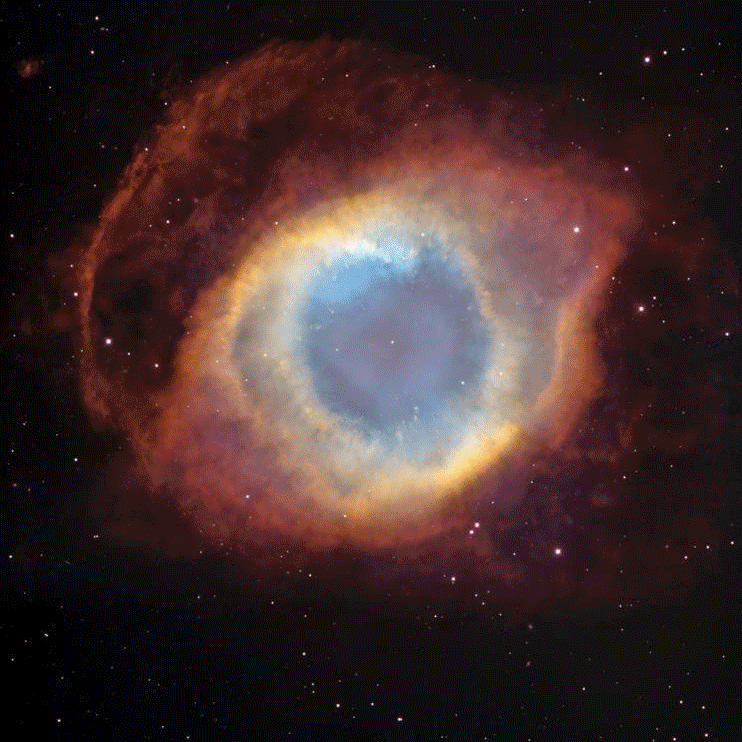
This image presents the Helix Nebula first at optical
wavelengths, as seen by the Hubble Space Telescope, then by
Herschel's SPIRE instrument at wavelengths around 250
micrometres.
Image credit:
Hubble image: NASA/ESA/C.R. O'Dell (Vanderbilt
University), M. Meixner & P. McCullough (STScI); Herschel
data: ESA/Herschel/SPIRE/MESS Consortium/M. Etxaluze et
al.
The Orion Nebula (also known as Messier 42), a diffuse nebula in the Milky Way south of Orion's belt, is one of the brightest nebulae. It is approximately 1,344 light years away (and 12 light years across), and contains hydroxyl radicals that interact with one another to form water. It is estimated that the nebula could generate enough water molecules in a single day to fill Earth's ocean 60 times over (as well as destroy water molecules on a massive scale).

The presence of water vapor near the Orion nebula is
indicated by an increased flux of infrared radiation at
specific wavelengths, which provide a unique fingerprint of
water molecules. The strength of the observed radiation
tells astrophysicists the concentration of water vapor that
is present.
Image credit:
Copyright: 2000-2024 © European Space Agency
The inverse: What can we learn about Early Earth that tells us about extraterrestrial life potential?
Biological processes dramatically impact all aspects of Earth, including its atmosphere. While we are lucky in that we can dig into (literally) Earth's surface and study the past, present, and future by looking at the lithosphere, biosphere, hydrosphere, cryosphere directly – in space, we are limited temporally, spatially, and technologically. By studying Earth's atmospheric history, scientists are able to look at what biomarkers were present at different stages in its evolution. This can then tell us what to look for in other planets, and will allow us to use our satellite-based data from other planets to make habitability evaluations!
Earth had three distinct atmospheres in its history: 1) from the solar nebula, lost soon after the planet itself accumulated, 2) the planet's interior outgassed, forming an atmosphere that was gravitationally held to the planet, and 3) Earth's modern atmosphere formed by life, tectonic activity (including volcanism and subduction) and even atmospheric escape.
Researchers are especially interested in the history of oxygen in the atmosphere, because as far as we know, oxygen is critical for much of life. On our planet, a rise in oxygen levels in the atmosphere co-occurred with evolution and expansion of complicated life on Earth. We find geologic evidence of changes in oxygen levels of our ancient atmosphere in ironstones; as we constrain them, the geochemical tools we use to identify changes in oxygen levels on Earth can be used in space, as well.
Finally, by studying simplistic life found in extreme environments in the ocean (including low-oxygen analogs like the Middle Island Sinkhole in Lake Huron, under glaciers in extreme Antarctica, in hydrothermal vents , and more) we can determine where we might find primitive (or more advanced) life on ocean worlds.
